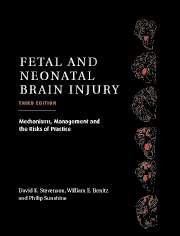Book contents
- Frontmatter
- Contents
- List of contributors
- Foreword
- Preface
- Part I Epidemiology, Pathophysiology, and Pathogenesis of Fetal and Neonatal Brain Injury
- 1 Perinatal asphyxia: an overview
- 2 Mechanisms of brain damage in animal models of hypoxia–ischemia in newborns
- 3 Cellular and molecular biology of perinatal hypoxic–ischemic brain damage
- 4 Fetal responses to asphyxia
- 5 Congenital malformations of the brain
- 6 Prematurity and complications of labor and delivery
- 7 Intrauterine growth retardation (restriction)
- 8 Hemorrhagic lesions of the central nervous system
- Part II Pregnancy, Labor, and Delivery Complications Causing Brain Injury
- Part III Diagnosis of the Infant with Asphyxia
- Part IV Specific Conditions Associated with Fetal and Neonatal Brain Injury
- Part V Management of the Depressed or Neurologically Dysfunctional Neonate
- Part VI Assessing the Outcome of the Asphyxiated Infant
- Index
- Plate section
8 - Hemorrhagic lesions of the central nervous system
from Part I - Epidemiology, Pathophysiology, and Pathogenesis of Fetal and Neonatal Brain Injury
Published online by Cambridge University Press: 10 November 2010
- Frontmatter
- Contents
- List of contributors
- Foreword
- Preface
- Part I Epidemiology, Pathophysiology, and Pathogenesis of Fetal and Neonatal Brain Injury
- 1 Perinatal asphyxia: an overview
- 2 Mechanisms of brain damage in animal models of hypoxia–ischemia in newborns
- 3 Cellular and molecular biology of perinatal hypoxic–ischemic brain damage
- 4 Fetal responses to asphyxia
- 5 Congenital malformations of the brain
- 6 Prematurity and complications of labor and delivery
- 7 Intrauterine growth retardation (restriction)
- 8 Hemorrhagic lesions of the central nervous system
- Part II Pregnancy, Labor, and Delivery Complications Causing Brain Injury
- Part III Diagnosis of the Infant with Asphyxia
- Part IV Specific Conditions Associated with Fetal and Neonatal Brain Injury
- Part V Management of the Depressed or Neurologically Dysfunctional Neonate
- Part VI Assessing the Outcome of the Asphyxiated Infant
- Index
- Plate section
Summary
Neonatal intracranial hemorrhage in the fullterm infant
Intracanial hemorrhage (ICH) in the full-term infant is less common than in the premature infant. The incidence and site of ICH in healthy, term neonates have been reported by sonographic evaluation to be 3.5%, with a subependymal location in 2.0%, choroid plexus locus in 1.1%, and a parenchymal locus in 0.4%. Clinically significant ICH in term infants, although uncommon, occurs in the subdural, intraventricular, and parenchymal areas, or in multiple sites.
Subdural hemorrhage in term infants
Subdural hemorrhage usually occurs secondary to birth trauma. These hemorrhages are relatively uncommon currently because of improvements in obstetric care. The pathogenesis is secondary to mechanical injury to the cranium associated with instrumental delivery with forceps or vacuum extraction of the head, abnormal presentation (face or brow), precipitous delivery, and a large infant resulting in a difficult delivery. There are shearing forces on the tentorium and the deep venous system. Tearing of the tentorium occurs, usually at the junction with the falx. Tearing of the falx or the superior cerebral veins occurs with less frequency. Tearing of the tentorium causes rupture of the straight sinus, the vein of Galen, transverse sinus, and infratentorial veins. Tearing of the falx involves the inferior sagittal sinus. Osteodiastasis of the occipital bones can produce tentorial tears and laceration of the inferior surface of the cerebellum.
The clinical presentation of infants is related to the extent of subdural hemorrhage. A massive subdural hemorrhage is associated with symptoms of midbrain compression (stupor, coma) followed by brainstem compression (fixed dilated pupils, bradycardia, and respiratory arrest).
- Type
- Chapter
- Information
- Fetal and Neonatal Brain InjuryMechanisms, Management and the Risks of Practice, pp. 175 - 188Publisher: Cambridge University PressPrint publication year: 2003
- 2
- Cited by



